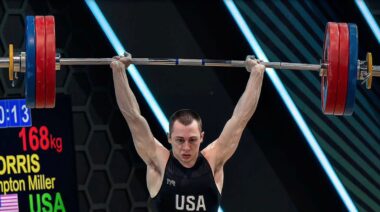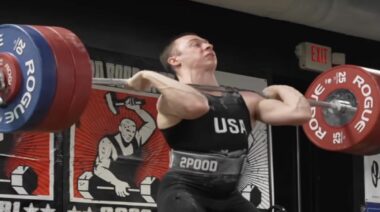The front squat is an exercise that’s absolutely vital for weight lifters, not only because of the necessity to come out of the squat clean but also because it works different muscle groups differently than the regular back squat.
The front squat is an exercise that’s absolutely vital for weight lifters, not only because of the necessity to come out of the squat clean but also because it works different muscle groups differently than the regular back squat.
Most people doing a back squat are going to find that they tend to bend the torso a little bit forward from the hip, and what that tends to do is it involves a hip extension a lot more in recovering from the deep position.
Whereas in a front squat, you’re able to sit with the torso much more upright and it places much more of the stress not only on the posterior chain in the back but also on the core muscles, especially the obliques and the transversus abdominis and rectus abdominis. Those muscles have to work hard, and they can really only be worked effectively while doing a front squat.
They’re not worked nearly as effectively while performing the back squat. Unless you are one of those unusual individuals who’s got very good ankle mobility and you can sit very upright in a back squat. Most people will find that they can back squat significantly more than they do in the front squat.
We’re looking at numbers like 131% of the clean and jerk in the back squat and 105% in the front squat. Personally, for the front squat, I prefer them to be higher. This will insure that the recovery from the deep squat in the clean is relatively easy and there is enough leg strength left for a successful jerk drive.
As in an interesting side not, there is a reason why I say 131% for the back squat. In the 1950s and 1960s there were frequent incidents of elite level weightlifters being forced to withdraw from competitions because of knee injuries. These types of situations have abated greatly and in today’s world level competition their occurrence is extremely rare. The reason for that, I believe, is the increase in the squat to clean and jerk ratio along with better selection of athletes.
In the late 1970s the Soviets gathered data and found that their best lifters had best back squats that averaged 131% of their best cleans and jerk. As time passed there was anecdotal evidence that many of the top lifters in the world had even higher figures.
As a coach I’ve used this 131% in calculating the target squatting figure for my athletes. For instance, if I am planning on having a lifter target a clean and jerk goal of 120 kg for the next cycle, I will plan all the training percentages for the back squat off of 157 kg or more, which is 131% of 120. This seems to provide the proper amount of loading on the individual, and enables to athlete to stand easily with whatever weight is cleaned.
Naturally there are variations among individuals, and since I work with Americans and we have no infrastructure for talent selection, the variations are even greater. Once my athletes have mastered technique, and their bodies have been balanced through training, we can plan on targeting back squatting weights at that 131% figure.
For both front and back squats, this can be difficult for those with especially long femurs and who are lifting at a less than optimal bodyweight. Others have excellent squatting leverages and can routinely exceed that target weight.
There are a few individuals, like I said, with good ankle mobility and a good upright posture in the bottom position of the back squat where those numbers are much closer.
For most people, they need to work extra hard on the front squat. It’s also going to place more of an emphasis on quad strength than the back squat does. In that way, it works the body differently.
Another thing that it does is it teaches the athlete to rack the bar and maintain a good position with the elbows up, therefore forming a rack that keeps the bar from rolling off the shoulders.
If anyone is planning on becoming an effective weightlifter, most of the time especially during preparation cycles, you’re doing back squats about twice a week and front squats maybe once a week. Then as you get closer to competition, you might change that ratio.
As you get further along and move up into master categories for the squat for weightlifting, you may find that you back squat as much as five or six days a week and front squat once.
Then as you get closer to competition, you’ll probably be back squatting maybe once or twice a week and front squatting twice a week. The incidents of front squatting is going to increase much more as you get closer to competition.
If you’ve been ignoring the front squat and you’ve been ignoring doing it correctly, you need to put that in if you’re going to have an effective clean and jerk. If you are a competitive athlete and want to learn more, you can try my Olympic Weightlifting Intermediate and Advanced Training which is what all my athletes follow. There’s also a Beginners program if you want to progressively improve your fundamental skills and prepare yourself to graduate to the higher levels.






